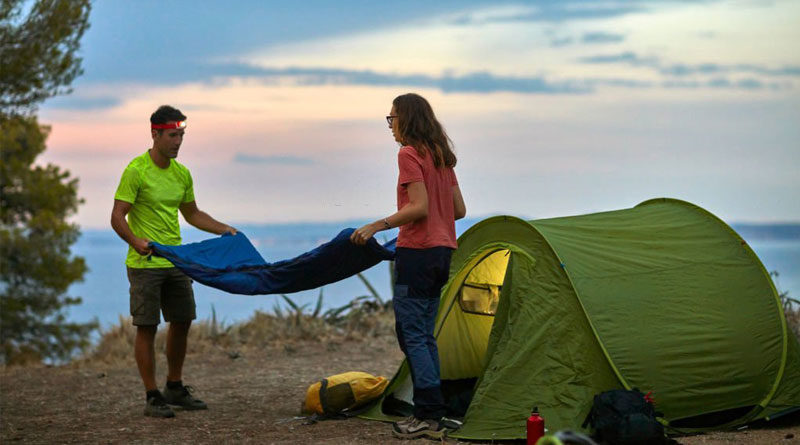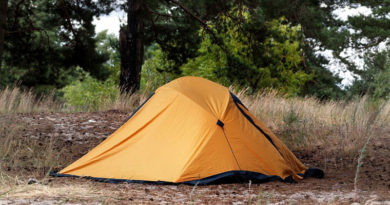Can You Use A Sleeping Bag Liner With A Quilt?
Sleeping bag liners have become popular over the past few years as they protect the sleeping bag from getting dirty and require washing. Washing a sleeping bag shortens its life by damaging the fabric and the fill inside.
But, lately, quilts are also gaining in popularity and more people are moving from sleeping bags to quilts. The natural question that arises is about the use of a sleeping bag liner with a quilt.
Short answer: Yes, you can! Quilts are essentially the same as sleeping bags with a few structural differences that are detailed below. But if you want to combine a sleeping bag liner with a quilt, you can and you should.
What is a Sleeping Bag Liner?
A sleeping bag liner is a piece of fabric that is shaped like a cocoon. It keeps you from coming in contact with your sleeping bag or quilt. The liner keeps the quilt or the sleeping bag from getting dirty with sweat, body oil, dirt, and grime.
Liners are not exactly important, per se. You can definitely sleep without them. In fact, they weren’t even popular a few years and have only gained popularity recently. They make things so much easier to manage. They are easier to wash and don’t require any careful treatment.
What is a Quilt?
Quilts, also called top quilts formally, are sleeping bags without the back, hood, and zipper. They do have a foot box to keep them from slipping off of you during the night. Top quilts were originally designed for hammock campers. A hammock camper usually has an underquilt hanging under the hammock which allows them to use a top quilt inside a hammock.
By cutting out the hood, zipper, and back, top quilts become much more lightweight than sleeping bags. The less weight of top quilts makes them attractive for ultralight backpacking. Backpackers today are choosing top quilts over sleeping bags because of their lightweight design and versatility.
Quilts keep you warm and are easy to carry. They are popular for camping in humid and hot conditions because they allow easy ventilation. Top quilts make thermal regulation easy. Based on the situation, you can cover yourself completely or simply take the quilt off for ventilation.
Many sleeping pads now come with an attachment system specifically designed for top quilts. This allows the quilt and the sleeping pad to become a single unit that is wrapped completely around you for utmost insulation.
How does the Liner/Quilt Combo Work?
It might surprise you but top quilts and sleeping bag liner combos are quite common among backpackers. With time, they are becoming popular as well.
- All manufacturers advise you to reduce the washing of a sleeping bag or quilt as much as possible. But when you are using them outdoors, they will get dirty because of the dirt, grime, sweat, and oils from your body. Sweat and body oils have certain degrading biochemicals. These biochemicals have a corrosive effect on the fabric and the fill (especially down fill) of your quilt or sleeping bag.
- Dirt and body fluids also start to smell so you are left with no choice but to wash the quilt. Washing damages the fabric and the fill of your quilt or sleeping bag. A liner works as a protective barrier in this case and you don’t have to wash your sleeping bag or quilt frequently. Less washing means you get to use your sleeping bag or quilt longer.
- One disadvantage top quilts have compared to sleeping bags is that they are drafty. While losing the hood, back, and the zipper does save weight, the open structure of the quilt provides less protection from drafts. This is a major disadvantage during cold nights.
- A sleeping bag liner provides extra protection from drafts by being an extra layer. Some liners come with a hood as well that provides even more protection. Furthermore, liners themselves add more warmth to a quilt keeping you well insulated.
- Liners also add comfort to your sleeping system if you are using a top quilt instead of a sleeping bag. Sleeping directly on a sleeping pad can feel uncomfortable. Silk or a microfleece sleeping bag liner can provide good comfort in such a case.
- Not every situation is ideal for using a quilt/liner combo, though. The combo is ideal for those who don’t like to sleep with their clothes on during summer nights. But if you sleep with your clothes on, then a liner would only be added weight.
- During winter nights, you would either have to sleep with layers of clothes or get in your clothes to operate during the night. Again, a liner becomes an added weight in such a case. The clothes provide protection of the liner in such a case. But during summer nights when you can sleep and stay with minimal clothing, sleeping bag liners are a great option to have.
Therm-a-Rest Corus: Best Quilt Option
Weight: 1 lb. 4 oz.
Rated to: 32°F
Fill: 650-fill-power NIKWAX hydrophobic down
Dimensions: 79 x 49.5 inches
Pack Size: 10 x 7 inches
If you are looking to ditch your sleeping bag with a lighter quilt, you might be hesitant to commit thinking if you made the right choice. But with the Therm-a-Rest Corus, you don’t have to go broke to find out. The Corus is a budget quilt that will allow you to test safely whether you would want to adopt a quilt over a sleeping bag. The Corus is rated for 35°F temperature. The 3-season quilt is ideal for use in hot spring, summer, and fall.
The Corus is extremely lightweight and compact making it a good option for backpacking trips. This 35°F quilt weighs less than 1.5lbs. The shell fabric is a durable 20D polyester with a water-repellent finish. Inside, you get 650 power NIKWAX hydrophobic down making it significantly more water-resistance than traditional down. The down also has an excellent warmth-to-weight ratio. The Corus has full-length insulated side baffles and the foot box is shaped to wrap the sleeping pad. These design features eliminate drafts and keep you well insulated.
The Corus has a host of additional features that help you add more warmth to the quilt. Integrated snaps at the sides of the quilt allow attachment of other Therm-a-Rest bags, sheets, and accessories. The included mattress snap kit allows you to securely attach the quilt to the sleeping pad for consistent warmth. The Corus is a good option if you are looking to experience quilts to escape your sleeping bag. You don’t break the bank and you get top-notch features for a reasonable price and less weight. A similarly performing sleeping bag would cost and weigh more.
What I like: Lightweight, hydrophobic down, most secure sleeping pad attachment system
What I don’t: Not for cold trips, the baffle construction reduces warmth
Cocoon Silk: Best Liner Option
Add Warmth: Up to 10°F
Weight: 4.7 oz.
Fabric: Silk
Best Use: Backpacking
The Austrian brand Cocoon has gained popularity for making some exceptional quality outdoor gear. The Cocoon Silk Mummy Liner is one such piece of gear. This liner is made of high-quality silk and is available in two models; regular and ripstop.
Even though this is a silk liner, it is very durable, especially, the ripstop version. The ripstop version is woven with reinforced threads at regular intervals to make it tear-resistant. As with all silk liners, the material is breathable, moisture-wicking, and quick-drying.
The liner also features a drawstring hood and also packs super small. The dimensions of the liner are roomy and make it feel like a rectangular-shaped liner even with a mummy shape. The overall weight of the liner along with the stuff bag is only 5oz. The liner is also a bit longer than other liners which makes it a good option for tall people.
What I like: Protects your expensive quilt, adds extra warmth, is lightweight, and packs small
What I don’t: You end up getting tangled during the night.
Final Thoughts
Sleeping bag liner and quilt combos are very popular among backpackers and campers. The liner protects the quilt from dirt, sweat, and body oils just like it does with a sleeping bag. That way you don’t have to wash your quilt frequently which makes the quilt last longer. Liners are also easier to wash than quilts and require no sophisticated treatment.
Most liners are machine washable which makes them easy to clean. Liners also add a little warmth and a layer of comfort to your sleeping system. The liner and quilt combo work just like the sleeping bag liner and sleeping bag combo. If you are considering buying a liner for your quilt, go for it.






